区块链数据分析框架-BlockSci
- 蒋年薪
- 发布于 2020-01-07 15:01
- 阅读 7106
像比特币、以太坊这样的区块链中包含了大量的数据,其中蕴藏着区块链生态系统中用户、企业和矿工的行为模式等重要信息。BlockSci是用C++开发的高性能的区块链数据分析框架,它可以帮助我们快速分析比特币等区块链的数据。本文将介绍BlockSci的安装方法,及如何利用BlockSci进行区块链数据分析。
安装BlockSci框架
BlockSci的主要开发语言是C++,本地编译需要GCC 7.2+和CLang 5+。 官方文档仅提供了Ubuntu 16.04和Mac OS10.13下的本地安装方法, 其他系统可以尝试本地安装或使用官方提供的AWS EC2镜像。
BlockSci框架概述
BlockSci包含两个主要的组件:解析器和分析库。
- 解析器用来解析区块链数据并转换为便于执行分析任务的BlockSci数据格式。
- 分析库则用来编写数据分析任务。
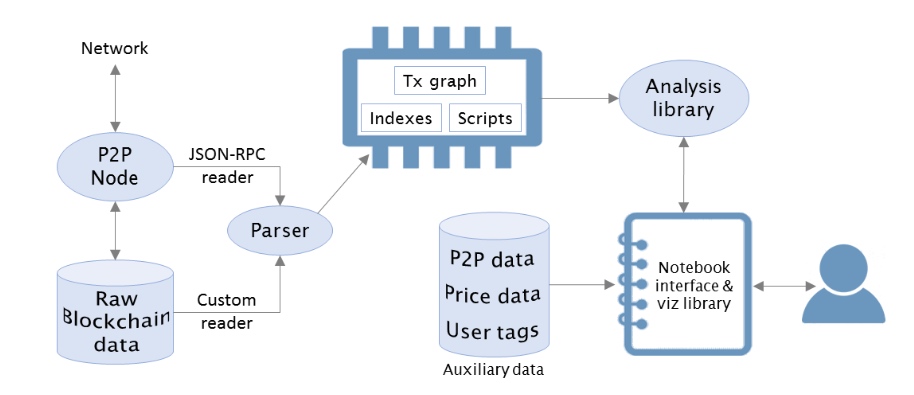
推荐使用64GB内存,BlockSci的运行需要大量内存,32GB虽然也可以用但性能下降非常明显。
BlockSci解析器 / Parser
BlockSci的解析器支持两种处理原始区块链数据的机制:磁盘模式和RPC模式。
-
磁盘模式是处理比特币区块数据的推荐模式,它可以直接读取并解析磁盘上的比特币区块数据文件,因此速度要快得多。但是这也意味着磁盘模式不能支持更多的区块链,因为不同的区块链的磁盘数据文件格式不同。
使用以下命令以磁盘模式解析比特币区块数据:
blocksci_parser --output-directory bitcoin-data update disk --coin-directory .bitcoin参数说明:
- –output-directory:解析结果输出目录
- –coin-directory:bitcoin core数据目录
-
RPC模式使用数据加密货币区块链节点的RPC接口来提取数据,而RPC接口是大多数(山寨币)区块链都支持的与比特币类似的二次开发接口(虽然优势也有一些差异),因此在比特币之外的区块链数据解析,BlockSci通常采用RPC模式,例如对于Zcash和Namecoin。
要使用RPC模式的BlockSci解析器,需要一个区块链全节点并且启用txindex选项。 命令格式如下:
blocksci_parser --output-directory bitcoin-data update rpc --username [user] --password [pass] --address [ip] --port [port]参数说明:
- –output-directory:解析结果输出目录
- –username:RPC API用户名
- –password:RPC API用户密码
- –address:RPC API监听地址
- –port:RPC API监听端口
BlockSci分析库 / Analysis Library
一旦利用解析器提取了区块链数据,就可以利用BlockSci的分析库来执行数据分析任务了。 BlockSci目前支持两种语言来开发区块链数据分析应用:C++和Python。
要使用C++版本的BlockSci分析库,需要添加必要的BlockSci头文件并链接BlockSci动态库。然后就可以利用解析器输出目录里的数据进行分析了,例如下面的代码:
#include <blocksci/blocksci.hpp>
int main(int argc, const char * argv[]) {
blocksci::Blockchain chain{"file_path_to_output-directory"};
}BlockSci目前仅支持Python 3,使用方法很简单:导入BlockSci库,然后利用解析器输出目录的数据构建Blockchain对象:
import blocksci
chain = blocksci.Blockchain("file_path_to_parser_output-directory")BlockSci区块链数据分析示例
这一部分我们使用Python版本的BlockSci来介绍如何进行比特币区块链的数据分析。
首先导入必要的库并利用解析器输出数据构建BlockSci的Blockchain对象:
import blocksci
import matplotlib.pyplot as plt
import matplotlib.ticker
import collections
import pandas as pd
import numpy as np
chain = blocksci.Blockchain('your_parser_data_directory')比特币地址类型使用情况分类统计
使用BlockSci的区块链对象的map_blocks()方法统计不同类型的地址在每年的使用量:
net_coins_per_block = chain.map_blocks(lambda block: block.net_address_type_value())
df = pd.DataFrame(net_coins_per_block).fillna(0).cumsum()/1e8
df = chain.heights_to_dates(df)
df = df.rename(columns={t:str(t) for t in df.columns})
ax = df.resample("W").mean().plot()
ax.set_ylim(ymin=0)显示结果如下:
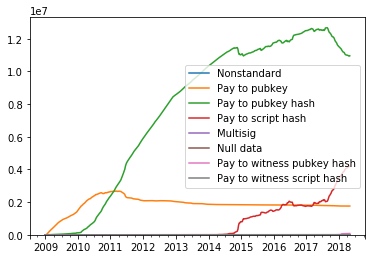
可以看到P2PKH地址的使用从2017年中开始减少,而P2SH地址的使用同期开始增加 —— 这应该对应着各种钱包对隔离见证地址支持 的增加。
比特币单区块交易手续费率可视化分析
下面的代码使用BlockSci的区块链对象的[]操作符提取比特币465100#区块内各交易的手续费率并进行可视化分析:
example_block_height = 465100
df = pd.DataFrame(chain[example_block_height].txes.fee_per_byte(), columns=["Satoshis per byte"])
ax = df.reset_index().plot.scatter(x="index", y="Satoshis per byte")
ax.set_ylim(0)
ax.set_xlim(0)
plt.show()显示结果如下:
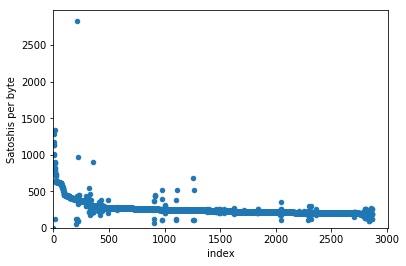
可以看到该区块内绝大多数交易的手续费率设置在500SAT/BYTE以内。
比特币二层协议使用情况可视化分析
在比特币交易内可以嵌入二层协议以实现对其他应用的支持,例如omni layer 的usdt代币就是最常见的一种比特币二层协议应用。下面的代码使用BlockSci的区块链对象的blocks.txes属性提取在交易输出中包含OP_RETURN脚本的交易,并显示二层协议的使用情况。
txes = chain.blocks.txes.including_output_of_type(blocksci.address_type.nulldata).all
labels = [(tx.block.time, blocksci.label_application(tx)) for tx in txes]
df = pd.DataFrame(labels, columns=["date", "label"])
df = df.reset_index().groupby(["date", "label"]).count().unstack(level=-1).fillna(0)
df.columns = df.columns.droplevel()
important_columns = list(df[df.index > pd.to_datetime("1-1-2016")].sum().sort_values()[-10:].index)
important_columns = [x for x in important_columns if "Address" not in x]
ax = df[df.index > pd.to_datetime("1-1-2016")].cumsum().resample("w").mean()[important_columns].plot()
ax.set_ylim(0)
plt.tight_layout()显示结果如下:
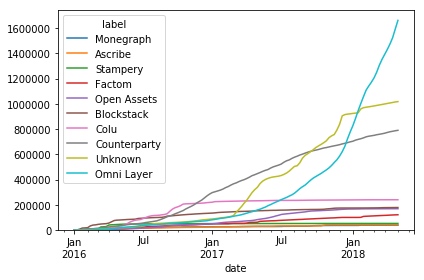
可以非常清楚的看到, Omni layer到目前已经是二层协议的最大用户。
比特币2017年各月平均交易手续费可视化分析
下面的代码统计年度平均手续费并将手续费换算为美元,注意其中利用了BlockSci分析库中的CurrencyConverter进行汇率换算:
converter = blocksci.CurrencyConverter()
blocks = chain.range('2017')
times = blocks.time
df = pd.DataFrame({"Fee":fees}, index=times)
df = converter.satoshi_to_currency_df(df, chain)
ax = df.resample("d").mean().plot(legend=False)
ax.set_ylim(ymin=0)
plt.tight_layout()显示结果如下:
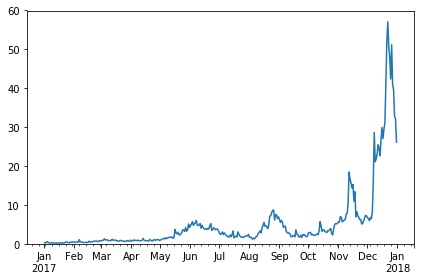
可以看到在2017年底比特币手续费激增。
比特币大额手续费交易可视化分析
下面的代码分析并可视化历年来手续费超过1000美元的比特币交易:
high_fee_txes = chain.cpp.filter_tx("fee(tx) > 10000000", 0, len(chain))
converter = blocksci.CurrencyConverter()
df = pd.DataFrame([(tx.block.height, tx.fee) for tx in high_fee_txes], columns=["height", "fee"])
df.index = df["height"]
df["fee"] = df.apply(lambda x: converter.satoshi_to_currency(x["fee"], chain[x["height"]].time), axis=1)
df = df[df["fee"] > 1000]
df = chain.heights_to_dates(df)
fig, ax = plt.subplots()
ax.plot_date(df.index, df["fee"], fmt="x")
ax.set_yscale("log")
formatter = matplotlib.ticker.ScalarFormatter(useOffset=False)
formatter.set_scientific(False)
ax.yaxis.set_major_formatter(formatter)
plt.tight_layout()显示结果如下:
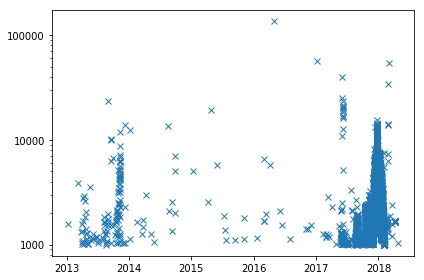
2017年超过1000美元手续费的交易激增,从一个侧面说明了这一年涌入了大量数字加密货币的新手。
- 密码朋克人物传之《 Hashcash 发明者 Adam Back》 103 浏览
- 《比特币开发哲学》:有限供给量 270 浏览
- 密码朋克人物传之《比特币核心开发者 Gavin Andresen》 66 浏览
- 密码朋克人物传之《比特币先驱 Hal Finney》 68 浏览
- 区块链基础教程 - 序言 401 浏览
- 比特币的诞生 293 浏览
- 比特币是如何运行的 305 浏览
- 本周加密货币市场(2025年12月8日) 624 浏览
- 精通比特币 第 3 版 - 序言 1930 浏览
- 密码朋克人物传之《比特币创造者 Satoshi Nakamoto》 76 浏览
- DAT 的公司模式终结了吗?比特币 treasury 公司的未来发展 318 浏览
- 加密货币本周动态 (2025年11月30日) 919 浏览

